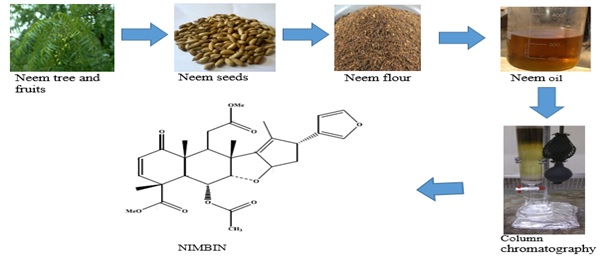Document Type : Original Research Article
Authors
1 Department of Chemistry, Faculty of Natural and Applied Sciences, Nasarawa State University Keffi, Nigeria
2 School of Chemistry, Bangor University, Bangor, UK
3 Department of Computational and Analytical Sciences, Rothamsted Research, Harpenden, UK..
Abstract
Azadirachta indica (neem), belonging to Meliaceae family and native to Asia, has been used therapeutically in traditional Ayurveda, Unani, several local systems within Africa and Chinese medicine to treat different diseases for long times. The phytochemical screening of the seed oil of these plants grown in Nigeria resulted in the isolation of nimbin from the methanol soluble fraction of the hexane extract. The structure of this compound was established on the basis of nuclear magnetic resonance (NMR), Infrared (IR) and mass (MS) spectroscopy. The obtained 1H and 13C NMR data of the compound was compared with those reported already in the literature. Finally, the identity of the compound was further substantiated by employing the X-ray crystallography. The compound was also subjected to antioxidant, antibacterial and brine shrimp lethality bioassay for further analyses. The pure compound showed poor antioxidant activity and was only moderately active against Escherichia coli among all the organisms tested. Moreover, the compound shows no cytotoxicity.
Graphical Abstract
Keywords
2. Nisbet AJ. Azadirachtin from the neem tree Azadirachta indica: its action against insects. Anais Socied. Entomol. Brasil. 2000;29:615-632.
3. Hossain MA, Nagooru MR. Biochemical profiling and total flavonoids contents of leaves crude extract of endemic medicinal plant Corydyline terminalis L. Kunth. Pharmacognos. J. 2011;3:25-30.
4. Kausar S. In vitro evaluation of antifilarial effect of Azadirachta indica leaves extract in different solvents on the microfilariae of Setaria cervi. J. Parasit. Diseas. 2017;41:9-15.
5. Ping ZY, Yong L, Ming PX. Global distribution and intro-duction cultivation state of. Azadirachta indica. Forest Invent. Plan. 2002;792:33-42.
6. Prieto P, Pineda M, Aguilar M. Spectrophotometric quantitation of antioxidant capacity through the formation of a phosphomolybdenum complex: specific application to the determination of vitamin E. Anal. Biochem. 1999;269:337-341.
7. Aladesuyi O, Ajanaku CO, Adedapo EA, Akinsiku AA, Sodiya FE. Adsorption properties of Azadirachta indicia extract on corrosion of Aluminium in 1.85 M Hydrochloric acid. J. Adv. Res. Appl. Sci. 2015;2:43-52.
8. Hussain HE. Reversal of diabetic retinopathy in streptozotocin induced diabetic rats using traditional Indian anti-diabetic plant, Azadirachta indica (L.). Indian J. Clin. Biochem. 2002;17:115-123.
9. Hossain MA, Al-Toubi WA, Weli AM, Al-Riyami QA, Al-Sabahi JN. Identification and characterization of chemical compounds in different crude extracts from leaves of Omani neem. J. Taibah Univ. Sci. 2013;7:181-188.
10. Bandyopadhyay U, Biswas K, Sengupta A, Moitra P, Dutta P, Sarkar D, Debnath P, Ganguly CK, Banerjee RK. Clinical studies on the effect of Neem (Azadirachta indica) bark extract on gastric secretion and gastroduodenal ulcer. Life Sci. 2004;75:2867-2878.
11. Sultana B, Anwar F, Przybylski R. Antioxidant activity of phenolic components present in barks of Azadirachta indica, Terminalia arjuna, Acacia nilotica, and Eugenia jambolana Lam. trees. Food Chem. 2007;104:1106-1114.
12. Ebong PE, Atangwho IJ, Eyong EU, Egbung GE. The antidiabetic efficacy of combined extracts from two continental plants:. Am. J. Biochem. Biotechnol. 2008;4:239-244.
13. Paul R, Prasad M, Sah NK. Anticancer biology of Azadirachta indica L (neem): a mini review. Cancer Biol. Therap. 2011;12:467-476.
14. Ogbuewu IP, Odoemenam VU, Obikaonu HO, Opara MN, Emenalom OO, Uchegbu MC, Okoli IC, Esonu BO, Iloeje MU. The growing importance of neem (Azadirachta indica A. Juss) in agriculture, industry, medicine and environment: A review. Res. J. Med. Plant. 2011;5:230-245.
15. Biswas K, Chattopadhyay I, Banerjee RK, Bandyopadhyay U. Biological activities and medicinal properties of neem (Azadirachta indica). Cur. Sci. Bangalore. 2002;82:1336-1345.
16. Johnson S, Morgan ED. Comparison of chromatographic systems for triterpenoids from neem (Azadirachta indica) seeds. J. Chromatograph. A 1997;761:53-63.
17. Silva JC, Jham GN, Oliveira RD, Brown L. Purification of the seven tetranortriterpenoids in neem (Azadirachta indica) seed by counter-current chromatography sequentially followed by isocratic preparative reversed-phase high-performance liquid chromatography. J. Chromatograph. A 2007;1151:203-210.
18. Narayanan CR, Pachapurkar RV, Pradhan SK, Shah VR, Narasimhan NS. Structure of nimbin. Chem. Indust. 1964;1:322-324.
19. Harborne JB. Introduction to ecological biochemistry. Academic press; 2014.
20. Wink M. Plant breeding: importance of plant secondary metabolites for protection against pathogens and herbivores. Theor. Appl. Gen. 1988;75:225-233.
21. Koleva II, Van Beek TA, Linssen JP, Groot AD, Evstatieva LN. Screening of plant extracts for antioxidant activity: a comparative study on three testing methods. Phytochem. Anal. 2002;13:8-17.
22. Nahar K, Khan MG, Rahman MS, Begum B, Rashid MA. Antimicrobial and cytotoxic activities of Bryophyllum daigremontianum. Dhaka Univ. J. Pharm. Sci. 2008;7:99-101.
23. Meyer BN, Ferrigni NR, Putnam JE, Jacobsen LB, Nichols DJ, McLaughlin JL. Brine shrimp: a convenient general bioassay for active plant constituents. Planta Med. 1982;45:31-34.
24. Oboh G, Rocha JB. Antioxidant in foods: a new challenge for food processors. Leading Edge Antioxidants Research, Nova Science Publishers Inc. New York US. 2007; pp. 35-64.
25. Harismah K, Mirzaei M, Fuadi AM. Stevia rebaudiana in food and beverage applications and its potential antioxidant and antidiabetic: mini review. Adv.Sci. Lett. 2018;24:9133-9137.
26. Harismah K, Vitasari D, Mirzaei M, Fuadi AM, Aryanto YH. Protection capacity of mosquito repellent ink from citronella (Cymbopogon nardus L.) and clove leaf oils (Syzygium aromaticum) againts Aedes aegypti. AIP Conf. Proc. 2017;1855:020023.
27. Hendratama H, Harismah K, Fuadi AM. Extraction optimization for antioxidant phenolic compounds in black grass jelly (Mesona palustris BL) using response surface methodology. IOP Conf. Ser. Mater. Sci. Eng. 2020;722:012019.
28. Puntel RL, Nogueira CW, Rocha JB. Krebs cycle intermediates modulate thiobarbituric acid reactive species (TBARS) production in rat brain in vitro. Neurochem. Res. 2005;30:225-235.
29. Ukaoma AA, Nwachukwu OM, Ukaoma OV, Adjeroh OL, Urenus I. Phytochemical and antimicrobial activity of neem seed oil (Azadirachta indica) on bacteria isolates. Int. Res. J. Nat. Sci. 2019;7:1-19.


